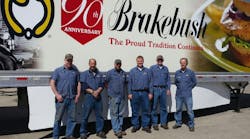Traffic on steroids
I live roughly 28 miles from the Fleet Owner office. On a good day, it takes me between an hour and an hour-and-a-half to get to work. But good days are hard to come by.
The magazine’s office is in a beautiful, wooded area in Stamford, CT. It really could be a tranquil place … unless you’ve been stuck in bumper-to-bumper traffic for two (sometimes three) hours. Those days, I typically arrive at the office shaking and on edge. The entire ride in, I obsess and stress about how productive I could have been had I not been stuck for hours on the Merritt Parkway, I-95, or whatever alternate route I decided to try that day.
And from what I’ve read—and experienced—sitting idle in traffic is really unhealthy. Every article or study I found linked a long commute and hours spent in traffic to depression, fatigue, stress, weight gain, increased exposure to air pollutants, and chronic physical pain.
Fortunately, I’m lucky enough to work for and with people who understand how awful my drive to the office is. Or maybe they’re just sick of hearing me complain about it every morning when I walk through the door. Either way, I’m able to work from home a couple of days a week. And for that I am truly grateful.
But professional truck drivers aren’t that lucky. Their livelihoods and the livelihood of our overall economy depend on them driving over crumbling infrastructure, through road closures and inconsistent weather, and enduring what I would call traffic on steroids in some parts of this country. To make matters worse, they have a tough time finding safe, adequate parking spaces to not only comply with their hours-of-service regulations, but to unwind when they need to.
According to research recently released by the American Transportation Research Institute (ATRI), traffic congestion on the U.S. National Highway System (NHS) added over $63.4 billion in operational costs to trucking in 2015. ATRI also calculated delays on the NHS totaling more than 996 million hours of lost productivity, which equates to 362,243 commercial truck drivers sitting idle for a working year. That’s a lot of lost productivity and a lot of headaches for these drivers.
The analysis also documented the states, metropolitan areas, and counties that were most impacted by these delays and subsequent cost increases. The top 10 states experienced costs of over $2 billion each, with Florida and Texas leading with over $5 billion each.
Traffic congestion tended to be most severe in urban areas, with 88% of the congestion costs concentrated on only 17% of the network mileage, and 91% of the total congestion costs occurring in metropolitan areas.
As part of its analysis, ATRI said it applied the 2015 national average operational cost per hour metric of $63.70 per commercial truck to the 996 million hours lost to traffic delays, which is how the group said it came up with the $63.4 billion in added industry operational costs due to traffic congestion.
Distributing this cost across the 11.2 million registered large trucks in the U.S. results in an average congestion cost per truck of $5,664, the group noted.
Mobile app developer TruckerPath recently issued a report analyzing the truck parking issue and found that many drivers lose an estimated 11 hours per month searching for truck parking, which amounts to around $600 of wages and an additional $60 of profit for the fleet.
TruckerPath also discovered that 79% of drivers it polled are forced to violate hours-of-service rules because they could not find parking. Lack of truck parking or the ability to quickly find parking cuts into driver productivity and reduces available on-duty time for driving.
And traffic congestion is mentally and physically taxing. Sitting in traffic is a fatigue-causing experience, so a trucker’s ability to rest and recover from it depends on adequate parking.
I’m not sure how we can improve these experiences for the men and women who haul freight and keep our economy moving. Focusing on fixing our transportation infrastructure to help alleviate some of the major traffic problems across this country would be a good start.



